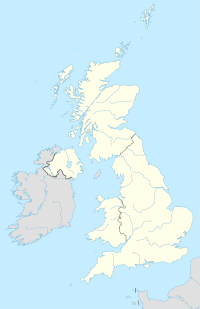Cromer
Coordinates: 52 ° 55 ′ 52 ″ N , 1 ° 18 ′ 5 ″ E
Cromer is a coastal town of about 7,800 people on the north coast of County Norfolk , England with a late Victorian pier. The city was the inspiration for the geological epoch Cromerium (also: Cromer warm period ) about 800,000 to 480,000 years ago.
history
Cromer is not mentioned in the so-called Domesday Book from 1086 . This book was an inventory of English possessions and settlements at the time. However, two settlements in this area are mentioned, Shipden-juxta-mere and Shipden-juxta-Felbrigg. It is believed that today's Cromer with its parish of St. Peter and Paul was built on the area of the Shipden-juxta-Felbrigg settlement. The other Shipden is now about 400 m northeast of Cromer Pier in the sea. This sunken place could still be located until 1888 because a rock protruded from the sea there, the so-called "Church Rock". After a ship was stranded there, however, this rock was blown up.
In the early 19th century, Cromer developed into a holiday resort, which the wealthy banking families from Norwich in particular liked to visit as a summer vacation spot. In 1883 the London journalist came to Cromer on behalf of the Great Eastern Railway and wrote several articles on the area. His depictions of the coastal region, which he referred to as the "poppy region", attracted attention across the country and ultimately led to the number of visitors steadily increasing. The name referred to the countless poppies that grow along the streets and in the meadows to this day. These are the effects of the opium poppy, which was once commercially grown in this area of Norfolk.
railroad
The first railway line reached the place in 1877 and 10 years later a second station was opened. There were direct connections to London, Manchester, Leicester, Birmingham, Leeds and Sheffield. Even the future King Edward VII came from London to play golf in Cromer. The Prince of Wales Cup is still played at the Royal Cromer Golf Club today. Nowadays there is only one feeder train to Norwich.
Specialties
The city is famous for its “Cromer Crab”, which is a major source of income for local fishermen. The crab is a delicacy and is bought and prepared by some restaurants right after the fishing boats enter. Over the centuries the city developed more and more into a fishing station. It can now be fished all year round. Crabs and lobsters in summer, herrings in autumn and cod in winter. While the beach was overcrowded with fishing boats in the 19th century, there are only 10 fishing boats left in the village today.
Lifeboat station

The fishermen are also famous as crews on the town's two lifeboats. The most famous sea rescuer was Henry Blogg , who was awarded the gold medal of the Royal Sea Rescue Society three times for his heroism. In addition, he received the silver medal four times. The Cromer Lifeboat Station was established in 1804 and was the first station in Norfolk. In the 19th century there were a lot of rowing boats stationed there along the coast. In 1920 a permanent station was built near the pier and a motorboat was purchased to make it easier to get over the waves. A series of famous rescue operations between 1917 and 1941 made Cromer and his rescue center famous throughout the country. Nowadays the lifeboat has to operate once a month on average, not least because the nearest ports ( Great Yarmouth 40 miles, Wells 25 miles) are so far away and boats from there cannot intervene in time.



